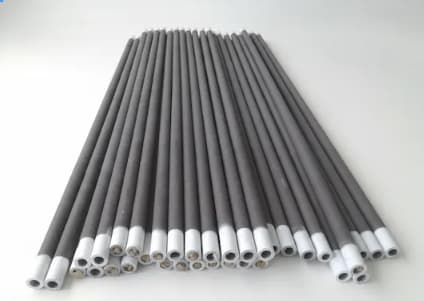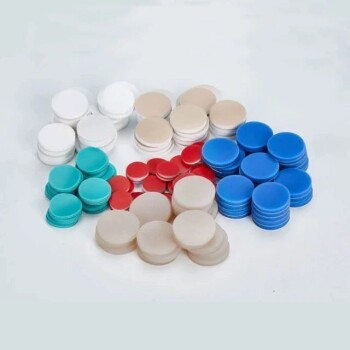Your high-temperature furnace just failed again. It's the third heating element this quarter, and each failure means costly downtime, a potentially ruined production batch, and another frustrating cycle of diagnosis and replacement. You specified silicon carbide (SiC) for its renowned high-temperature performance, so why does it keep failing? The problem isn't SiC itself, but a critical, often-overlooked distinction in how these components are made.
The Dragon in the Furnace: Premature Element Failure

For engineers and researchers working in fields like semiconductor manufacturing, ceramics, and metallurgy, process temperature is not just a variable; it's the foundation of their work. The challenge—the dragon that guards the gates of innovation and efficiency—is maintaining precise, stable heat in chemically aggressive, high-temperature environments over long periods.
Many standard heating elements fail to meet this challenge. They are often manufactured from a composite material where an organosilicon resin is used as a binder for carbon powder. While technically a "silicon carbide" product after heat treatment, this method introduces a fundamental weakness. At extreme operating temperatures, the residual compounds from the resin binder can degrade. This leads to:
- Inconsistent Performance: The element's resistance changes over time, causing temperature fluctuations that ruin process control.
- Mechanical Failure: The material becomes brittle, leading to cracks and complete failure, especially under thermal cycling.
- Process Contamination: Outgassing from the degrading binder can introduce impurities into sensitive environments, a catastrophic event in semiconductor or specialty glass production.
This recurring failure isn't a random defect; it's an inherent limitation of a material not truly designed for the most demanding applications.
The Breakthrough: High-Purity Sintered SiC
The solution to this persistent problem emerged from a deeper understanding of SiC's material science. A new class of SiC heating elements, created through a fundamentally different process, represented the breakthrough needed to finally slay the dragon of unreliability.
What They Did
Instead of using organic binders, researchers perfected a method of directly sintering a precise mixture of high-purity silicon and carbon powders at extremely high temperatures.
How They Did It
This process forges strong, direct covalent bonds between silicon and carbon atoms, creating a dense, uniform, and highly stable crystalline structure (specifically, the desirable β-SiC crystal form). This eliminates the weak points and potential contaminants associated with resin binders.
What They Found
The resulting material, a high-purity sintered Silicon Carbide, demonstrated vastly superior properties. It exhibited exceptional resistance to oxidation and chemical corrosion even in aggressive atmospheres. Its mechanical strength and dimensional stability at temperatures exceeding 1400°C were an order of magnitude better than its composite counterparts, allowing it to operate reliably for thousands of hours where other elements failed in hundreds.
The Unsung Hero: The Lab Equipment That Makes Purity Possible
This breakthrough from a failure-prone composite to a hyper-reliable material was not an accident. Achieving this level of purity and crystalline perfection depends entirely on the precision and reliability of the laboratory equipment used for its development and quality control.
This is where the true enabling technology is revealed. The ability to create high-purity sintered SiC is fundamentally tied to having:
- Ultra-High-Temperature Furnaces: Equipment capable of reaching and holding precise temperature profiles required for the sintering process, without introducing contaminants.
- Atmosphere-Controlled Systems: The ability to manage the gaseous environment during heat treatment is critical to prevent unwanted side reactions and ensure the formation of the correct SiC crystal structure.
- Material Characterization Tools: Rigorous testing and analysis to verify the density, purity, and mechanical properties of each batch, ensuring it meets the stringent requirements for high-performance applications.
The development of superior materials like sintered SiC is impossible without a foundation of elite laboratory infrastructure. These are not just tools; they are the necessary condition for innovation.
A New Dawn for High-Temperature Industries
The impact of reliable, high-purity SiC heating elements extends far beyond reducing furnace downtime. It unlocks a new level of process capability and economic value across multiple industries.
For semiconductor manufacturers, it means higher yields and the ability to explore next-generation processes that require pristine, stable high-temperature environments. In ceramics and metallurgy, it allows for the creation of advanced materials with superior properties, as the heat treatment process itself is no longer the weakest link. For any engineer or scientist whose work is constrained by temperature, this represents a new horizon of possibility.
The integrity of your final product often depends on the unseen components in your process, like the heating elements discussed here. But your challenges—whether in material synthesis, quality assurance, or process scaling—are unique. To achieve the next level of performance and reliability requires a deep understanding of both the materials and the equipment used to create and test them. If you're ready to move beyond recurring failures and unlock new capabilities, let's discuss the specific demands of your application.
Related Products
- Silicon Carbide SiC Thermal Heating Elements for Electric Furnace
- Molybdenum Disilicide (MoSi2) Thermal Elements Electric Furnace Heating Element
- Laboratory Muffle Oven Furnace Bottom Lifting Muffle Furnace
- 1200℃ Split Tube Furnace with Quartz Tube Laboratory Tubular Furnace
- High Quality Alumina Ceramic Screw for Engineering Advanced Fine Ceramics with High Temperature Resistance and Insulation
Related Articles
- Effective Maintenance Strategies for Vertical Tubular Electric Furnaces
- Dos and don'ts during the installation of molybdenum disilicide (MoSi2) heating element
- Why Your High-Temperature Furnace Elements Keep Failing (And How to Stop It)
- Investigating the Factors Affecting the Slow Temperature Rise in Box Furnaces
- Electric Heating Systems(3): Understanding, Benefits, and Applications




















